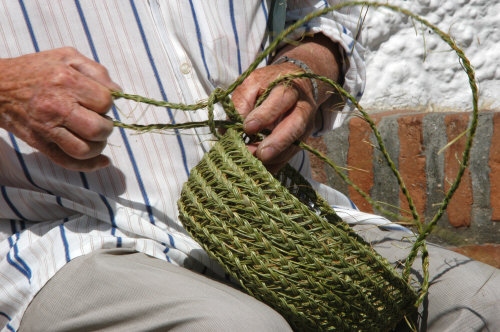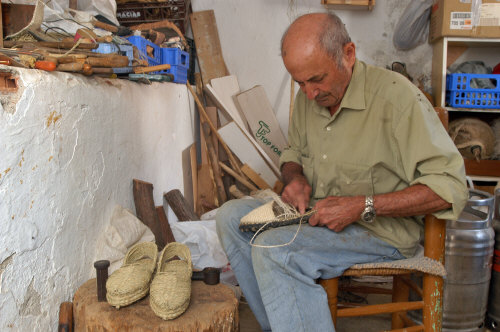|

ESPARTO
GRASS, PALM AND PITA GRASS CRAFTS
Vegetal fibres have been worked in many
places for the manufacture of various
utensils but such craftsmanship has only
been preserved in some of them. Fortunately,
there are still artisans in our region who
use techniques similar to those used in
textile manufacture, working esparto grass,
palm and pita.

The working of esparto grass (Stipa
tenacissima) starts with its harvesting from
July to September. It can be worked when
green, or dried and pounded. Green esparto
is worked directly and from it are obtained
small pieces of basketwork, pleitas (strips
of esparto or palm plaited into several
strands which, when sewn together with
others, are used to make mats, hats,
cigarette cases and other items) and smaller
pleitas for the manufacture of cheeses, etc.
Customarily, sheafs of esparto are stored
for working during the rest of the year.
Being dry fibre, it is necessary to boil it
and soak it for two weeks so that it is
flexible enough to plait. Pounding of the
esparto is done with majas (wooden maces),
beating the blades of esparto against a
stone which acts as a base. Once the esparto
is sufficiently pliable, the strands are
plaited, ie, the pleita is made. The pleitas
are then sewed together until the desired
article is created, for example, baskets,
mats, panniers, etc.

The leaf of the palm tree (chamaerops
humilis) is another of the fibres used by
the inhabitants of the Sierra de las Nieves.
It is collected from June to August and
placed in the sun for a month until dry.
When ready, it is bleached by placing it in
a drum next to a container with burning
sulphur inside. Once prepared, the leaves
are cut into small strips from which are
obtained the strands used to make the
pleitas. The manufacturing process continues
in much the same way as with esparto with
one difference: being a lighter material it
can be used to make other objects like hats,
fans for the fire, cigarette cases, baskets
for figs and raisins, etc.
The pita (agave americana) is a plant native
to Mexico which has acclimatised perfectly
to the Sierra de las Nieves. From its large
and meaty leaves are extracted threads which
are used to make twine, rope, slings and
other utensils of everyday use in the
Sierra. In Casarabonela, another use has
been found for the plant: the production of
zambombas (friction drums) using the shoot
(the herbaceous stem without leaves that
holds the flowers and fruit of the plant).
|